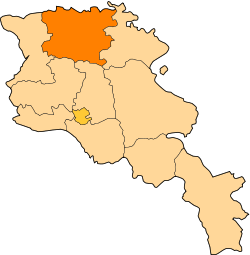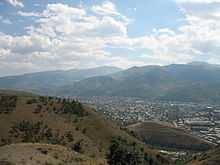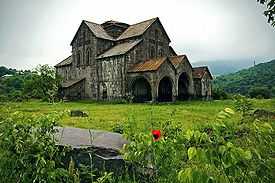Lori Province
| Lori Լոռի | ||
|---|---|---|
| Province | ||
|
Lori Province administration in Vanadzor | ||
| ||
 Location of Lori within Armenia | ||
| Coordinates: 40°55′N 44°30′E / 40.917°N 44.500°ECoordinates: 40°55′N 44°30′E / 40.917°N 44.500°E | ||
| Country | Armenia | |
| Capital | Vanadzor | |
| Government | ||
| • Governor | Artur Nalbandyan | |
| Area | ||
| • Total | 3,799 km2 (1,467 sq mi) | |
| Area rank | 3rd | |
| Population (2011) | ||
| • Total | 235,537 | |
| • Rank | 6th | |
| • Density | 62/km2 (160/sq mi) | |
| Time zone | UTC+04 | |
| • Summer (DST) | UTC+05 (UTC) | |
| Postal code | 1701–2117 | |
| ISO 3166 code | AM.LO | |
| FIPS 10-4 | AM06 | |
| Website | official website | |
| Part of a series on |
| Armenia Հայաստան |
|---|
  |
| Culture |
| History |
| Demographics |
| Administrative divisions |
|
| Armenia portal |
Lori (Armenian: Լոռի, Armenian pronunciation: [lɔˈri]) is a province (marz) of Armenia. It is located in the north of the country, bordering Georgia. Vanadzor is the capital and largest city of the province. Other important towns include Stepanavan, Alaverdi and Spitak. It is home to the UNESCO World Heritage Sites of Haghpat and Sanahin monasteries and the well-preserved Akhtala monastery, where Armenians, Georgians, and Greeks make an annual pilgrimage on September 20–21.[1] Lori borders Tavush province in the east, Kotayk in the southeast, Aragatsotn in the southwest and Shirak in the west.
Lori is the birthplace of several famous Armenians including musician Sayat-Nova, Armenia's national poet Hovhannes Tumanyan, Soviet aircraft designer Artem Mikoyan, and Soviet statesman Anastas Mikoyan.
The province was severely affected by the 1988 Armenian earthquake.
History
Lori was known as Tashir in antiquity.[2] Until the 5th century, Tashir was part of the Gugark region of Greater Armenia.[3][4]
The name Lori (Լոռի, known as Lore ლორე in Georgian) did not appear until the 10th century, when the Armenian Kingdom of Lori (Tashir-Dzoraget) was established by Kiurike I with the help of Georgia and another Armenian Kingdom of Vaspurakan. In the 11th century, David the Landless founded the fortified city of Lori (or Lore).[5] The fortress-city became the kingdom's capital in 1065. The name Lori later spread through the region and replaced Tashir.[4]
The Seljuks invaded the region in the early 12th century, but their rule did not last long and in 1118-1122 the Georgian king David the Builder conquered Lori and gave it to the Georgian-Armenian Orbeli dynasty. The Orbeli revolted unsuccessfully in 1177, after which a Kipchak named Khubasari was appointed spasalari of Lori. The province became subject to the Zakarian dynasty when in 1185 Tamar of Georgia appointed prince Sargis Zakarian as its governor.[4]
Between 11th and 13th centuries, the monasteries of Haghpat, Sanahin, Kobayr and the Bardzrakash in Dsegh served as centers of Armenian culture and science. Scholars such as Hovhannes Imastaser, Grigor Tuteordi, Davit Kobayretsi, Grigor Magistros worked in these monasteries.[4] The region was devastated by the Mongol invasion of 1236, and the Zakarian dynasty declined by the 14th century.[4]
Lori was annexed by Safavid Persia in accordance to the 1555 Peace of Amasya and became part of Persia's Kartli-Kakheti province. After Nadir Shah's murder in 1747, the Georgian kingdoms of Kartli and Kakheti became independent and united into a single kingdom by 1762.[6] In 1801, together with Georgian provinces of Kartli and Kakheti, Lori was annexed by the Russian Empire.[4] In 1850, Lori was incorporated into the Erivan Governorate. In 1862, it was transferred into the jurisdiction of the Tiflis Governorate. In 1880, Lori became part of the Borchali okrug of the Tiflis Governorate. In the early 20th century, Lori was mostly Armenian-populated with several Russian and Greek villages.[4]
In late 1918, Armenia and Georgia fought a border war over Lori. It was put under a British control as a neutral zone. Following Armenia's sovietization in late 1920, Lori was incorporated into Soviet Armenia.[4]
Communities
The province of Lori consists of the following 113 communities (hamaynkner), of which 8 are considered urban and 105 are considered rural.[7]
Towns or urban communities
| Image | City (town) | Province | Founded | Land area (km2) | Population (2011 est.) |
|---|---|---|---|---|---|
 | Akhtala | Lori | 18th century (first mentioned) | 4.3 | 2,400 |
 | Alaverdi | Lori | 17th century (first mentioned) | 18 | 15,800 |
 | Shamlugh | Lori | 1770 | 3.6 | 700 |
 | Spitak | Lori | 17th century | 5.6 | 15,300 |
 | Stepanavan | Lori | 1810 | 14 | 15,800 |
 | Tashir | Lori | 1844 | 5.6 | 8,700 |
 | Tumanyan | Lori | 1926 | 1 | 1,700 |
 | Vanadzor | Lori | 1828 | 32 | 105,000 |
Villages or rural communities
- Agarak
- Ahnidzor
- Akori
- Amrakits
- Antaramut
- Antarashen
- Apaven
- Ardvi
- Arevashogh
- Arevatsag
- Arjut
- Artsni
- Atan
- Aygehat
- Aznvadzor
- Bazum
- Blagodarnoye
- Bovadzor
- Chkalov
- Chochkan
- Darpas
- Dashtadem
- Debet
- Dsegh
- Dzoraget
- Dzoragyugh
- Dzoramut
- Dzyunashogh
- Fioletovo
- Gargar
- Geghasar
- Ghursali
- Gogaran
- Gugark
- Gyulagarak
- Haghpat
- Hagvi
- Halavar
- Hartagyugh
- Hobardzi
- Hovnanadzor
- Jiliza
- Jrashen
- Kachachkut
- Karaberd
- Karadzor
- Karinj
- Karkop
- Karmir Aghek
- Katnaghbyur
- Katnajur
- Katnarat
- Khnkoyan
- Koghes
- Kurtan
- Lejan
- Lermontovo
- Lernahovit
- Lernantsk
- Lernapat
- Lernavan
- Lori Berd
- Lorut
- Lusaghbyur
- Margahovit
- Marts
- Medovka
- Meghvahovit
- Mets Ayrum
- Mets Parni
- Metsavan
- Mghart
- Mikhayelovka
- Nor Khachakap
- Norashen
- Neghots
- Novoseltsovo
- Odzun
- Paghaghbyur
- Pambak
- Petrovka
- Privolnoye
- Pushkino
- Sarahart
- Saralanj
- Saramej
- Saratovka
- Sarchapet
- Shahumyan
- Shamut
- Shenavan
- Shirakamut
- Shnogh
- Sverdlov
- Teghut
- Tsaghkaber
- Tsaghkashat
- Tsater
- Urasar
- Urut
- Vahagnadzor
- Vahagni
- Vardablur
- Yaghdan
- Yeghegnut
Non-community villages
- Lori
-

Northern Lori as seen from Pushkin mountain pass
-

Pambak River at Vanadzor countryside
-

Akhtala monastery
-
.jpg)
Fioletovo village
References
- Report of the results of the 2001 Armenian Census, National Statistical Service of the Republic of Armenia
- ↑ Tadevosyan, Aghasi (2007). Historical Monuments of Armenia: Akhtala. Yerevan, Armenia: "Var" Center for Cultural Initiatives. ISBN 978-99941-2-070-3.
- ↑ Hacikyan, Agop Jack; Basmajian, Gabriel; Franchuk, Edward S.; Ouzounian, Nourhan (2000). The Heritage of Armenian Literature: From the Oral Tradition to the Golden Age 1. Detroit: Wayne State University Press. p. 172. ISBN 9780814328156.
- ↑ Hacikyan, Agop Jack; Basmajian, Gabriel; Franchuk, Edward S.; Ouzounian, Nourhan (2005). The Heritage of Armenian Literature: From the eighteenth century to modern times 2. Detroit: Wayne State University Press. p. 386. ISBN 9780814332214.
- ↑ 4.0 4.1 4.2 4.3 4.4 4.5 4.6 4.7 Matevossian, R. (1978). "Լոռի [Lori]". In Hambardzumyan, Viktor. Soviet Armenian Encyclopedia (in Armenian) 4 (Yerevan: Armenian Encyclopedia). pp. 663–64. Missing or empty
|title=(help) - ↑ Hewsen, Robert H. (2001). Armenia: A Historical Atlas. Chicago: University of Chicago Press. p. 114. ISBN 0-226-33228-4.
- ↑ Suny, Ronald Grigor (1994). The Making of the Georgian Nation. Bloomington: Indiana University Press. pp. 55–56. ISBN 9780253209153.
- ↑ "RA Lori Marz". Marzes of the Republic of Armenia in Figures, 2002–2006. National Statistical Service of the Republic of Armenia. 2007.
See also
- Kingdom of Lori
External links
| ||||||||||||


